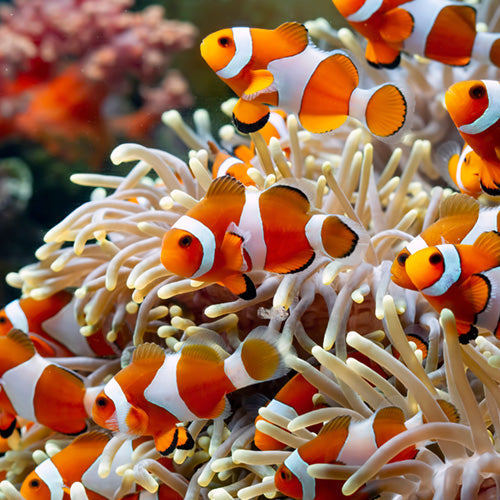Save the ocean, save the world
Oceans cover 71% of this big blue planet1 and are home to important species and ecosystems we rely on for food, livelihoods and so much more. Most importantly? The oceans are key to climate regulation2 and they need our help!
In many places, the ocean has become a rubbish dump. Millions of tons of litter ends up in the sea3 and overfishing is threatening whole ecosystems4. Saving something so enormous can feel like such an immense task – is there really anything we can do? Yes! If we all make an effort, we can of course make a huge impact.

Here are ten things you can do to help protect our oceans:
1. Pick up garbage and litter around and on waterways
We’ve all seen the heart-breaking photos of seabirds, turtles, seals and other animals eating floating litter by mistake, or becoming tangled in plastic garbage. So next time you’re having a day of sunbathing, take it from the team at Take 3 For The Sea and take three pieces of litter home with you. Recycle or put securely in landfill, and you’ve made a difference.
While you’re at it – don’t forget to avoid the single-use items, and BYO reusables to your beach day.
2. Ditch the microbeads
How does scrubbing your face with plastic beads sound? Well, depending on where you are in the world, you could be doing just that. Microbeads are found in cosmetics, toothpastes and cleaning products. Manufacturers use them because the beads can be made with uniform size and hardness and yes - they’re cheap. Microbeads are not captured by most wastewater treatment systems so they’re washed down drains and into rivers, lakes and oceans. There they’re causing all sorts of problems – the most dangerous is when they’re eaten by tiny marine animals who are an important food source for other animals. They fill up on plastic, starve to death and leave their predators with nothing to eat. The plastic itself, or the pollutants it carries can also poison these creatures.5
3. Say no to meat and seafood
According to estimates from WWF, three-quarters of the world’s fisheries are fully exploited or overfished. They write, “Poor fisheries management, exacerbated by climate change, is the largest threat to ocean life and habitats ... and to the livelihoods and diets of more than a billion people.”
The next time you see fish on the menu or you’re at the supermarket, remember that you can choose to reduce the demand for exploited species. If you’re a Kiwi, read this for more information on sustainably sourced seafood: Sustainable seafood in New Zealand by Eat Well.
Avoiding meat seems a bit tangential, but mass animal farming is devastating our waterways and oceans. These animals don’t only produce methane, a powerful greenhouse gas, but the run-off from artificially fertilized paddocks adds too much nutrient to water, creating dead zones and excessive plankton and algae, and creating death on a massive scale.
4. Lower your plastic consumption
Over 40% of total plastic use comes from product packaging – and only 9% of all plastic6 is actually recycled. That means we can’t rely on recycling to solve the problem. We need to avoid plastic pollution at its origin! There are so many changes you can make to reduce your plastic consumption: buy produce with no packaging, invest in clothing made with less or no synthetic fibers, research reusable counterparts to your single-use items, e.g. face cloths over makeup wipes and reusable cups over single-use coffee cups.
Check out these blogs for some more tips:
5. Lower your carbon footprint
Have you heard of ocean acidification7? It’s one of the mind-blowing things I learnt in 2019. It’s basically what excess carbon dioxide (CO₂) is doing to the ocean. CO₂ gas naturally moves between the atmosphere and the oceans. Now that humans have increased the amount of CO₂ in the atmosphere, more of is being absorbed by the ocean, which makes seawater more acidic.
That’s bad news for our ocean pals – the rise in acidity levels is devastating. The harder parts and shells of animals like coral, starfish, oysters and mussels can weaken with this change8. Weak shells break easily or don’t grow as well.
Easy ways to lower your carbon footprint: Eat local and in-season produce, stop buying clothes, especially fast fashion, reduce your food waste, and buy less stuff! Opt for public transport, biking or walking as much as possible and dry your clothes outside on the line – just to name a few!
6. Say no to ocean souvenirs
Of course, buying from local artisans and craftspeople helps local communities, but when you do buy, avoid products made through unsustainable or environmentally harmful methods. Say no to buying products made from coral, shark and turtle or tortoise shell.
7. Rethink your choice in sunscreen
Coral reefs – those totally beautiful, and incredibly important living structures – are under increasing threat around the world, and (surprise, surprise) that’s mostly because of climate change9. Warmer waters and ocean acidification (caused by more dissolved carbon dioxide in there) are the main culprits, but there’s another, more unexpected threat - sunscreen worn by swimmers and snorkelers, which causes and exacerbates coral bleaching. Do you need to rethink your choice of sunscreen? Read our in-depth blog here: Is your ‘reef-safe’ sunscreen really reef safe?
8. Speak up!
One of the easiest ways to help is to just talk about it! Stay informed on issues related to ocean health and make others aware of the problem. Tell your friends and family about how they can be part of the solution – as with everything, we just need everyone to make small changes.

9. Hands off
We humans are lumbering, warm-bodied, disease-laden oafs. Touching sea life, even really, really gently, should be 100% out of bounds. Why? Because you’ll probably hurt it, either by damaging its fragile structure or by triggering extreme defense mechanisms (sea cucumbers expel their intestines!) Many fish have a mucous barrier that helps them fight disease – human touch can damage this layer, opening the fish up to illness, while also directly introducing our foreign bacteria. So if you’re diving, swimming or snorkeling, look but don’t touch!
10. Support organizations, political parties and companies who fight for ocean health
There’s only so much you can do personally – saving the oceans needs organization on a grand scale. So when you’re voting, either in local or national elections, seek out parties and individuals who put the oceans and our environment in their list of priorities. Find companies who are actively working towards the good of the earth and donate to organizations working to protect and restore massive parts of our ocean – we love Mission Blue.
Sources
- Smithsonian Ocean (2018 April 22). Just How Big Is the Ocean? si.edu
- Thornton, P. E., Doney, S. C., Lindsay, K., Moore, J. K., Mahowald, N., Randerson, J. T., ... & Lee, Y. H. (2009). Carbon-nitrogen interactions regulate climate-carbon cycle feedbacks: results from an atmosphere-ocean general circulation model. Biogeosciences, 6(10), 2099-2120. https://www.biogeosciences.net/6/2099/2009/bg-6-2099-2009.pdf
- National Oceanic and Atmospheric Administration (2018 June). Ocean pollution | Each year, billions of pounds of trash and other pollutants enter the ocean. gov/education
- Jackson, J. B., Kirby, M. X., Berger, W. H., Bjorndal, K. A., Botsford, L. W., Bourque, B. J., ... & Hughes, T. P. (2001). Historical overfishing and the recent collapse of coastal ecosystems. science, 293(5530), 629-637 https://www.ncbi.nlm.nih.gov/pubmed/11474098
- Andersson, E. (2014). Micro Plastics in the Oceans and their Effect on the Marine Fauna. https://stud.epsilon.slu.se/6634/
- Geyer, R., Jambeck, J. R., & Law, K. L. (2017). Production, use, and fate of all plastics ever made. Science advances, 3(7), e1700782. doi:10.1126/sciadv.1700782. nlm.nih.gov
- Borunda, A. (2019 August 7). Ocean acidification, explained. com
- Anthony, K. R. N., Kline, D. I., Diaz-Pulido, G., Dove, S., & Hoegh-Guldberg, O. (2008). Ocean acidification causes bleaching and productivity loss in coral reef builders. Proceedings of the National Academy of Sciences of the United States of America, 105(45), 17442. https://www.pnas.org/content/105/45/17442
- Hughes, T. P., Baird, A. H., Bellwood, D. R., Card, M., Connolly, S. R., Folke, C., ... & Lough, J. M. (2003). Climate change, human impacts, and the resilience of coral reefs. science, 301(5635), 929-933. https://www.ncbi.nlm.nih.gov/pubmed/12920289
- Danovaro, R., Bongiorni, L., Corinaldesi, C., Giovannelli, D., Damiani, E., Astolfi, P., ... & Pusceddu, A. (2008). Sunscreens cause coral bleaching by promoting viral infections. Environmental health perspectives, 116(4), 441-447. https://www.ncbi.nlm.nih.gov/pmc/articles/PMC2291018/

 Impact
Impact Blog
Blog Store Locator
Store Locator

